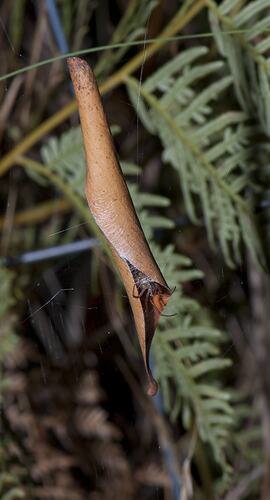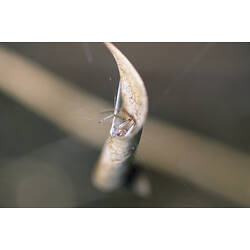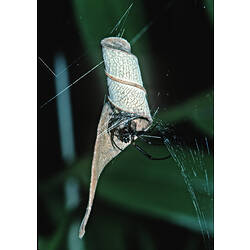General Description
Cephalothorax and legs red-brown, abdomen with an irregular creamy-yellow chevroned pattern on the upperside. Stout, oval-shaped abdomen with slender, long legs. Body of males to 5 mm, females to 8 mm long.
Biology
The leaf-curling spider is commonly found throughout southern Australia in open woodland and forest habitats as well as urban gardens. It normally uses a leaf in the centre of the web for protection, mainly from birds, but many other objects may be used as a shelter in the web including snail shells and old bus tickets. Large numbers of this spider may occur in a localised area; however, unlike the spiny spider, all webs are solitary. Food consists mainly of flying insects. Egg sacs are placed inside a folded leaf suspended some distance outside the main web.
Distribution
Eastern mainland Australia and Tasmania.
Habitat
Open woodland, forest habitats and urban gardens.
More Information
-
Animal Type
-
Animal SubType
-
Brief Id
Resides in orb web with curled leaf or other retreat placed in the centre; body with creamy-yellow pattern on the abdomen.
-
Colours
Brown, Red, White
-
Maximum Size
8.0 mm
-
Habitats
-
Where To Look
-
Diet
Insects
-
Hazards
Bites from this spider are rare but may cause local reaction, including localised pain and swelling at the site of the bite.
-
Endemicity
-
Conservation Statuses
CITES: Not listed, FFG Threatened List: Not listed, EPBC Act 1999: Not listed, IUCN Red List: Not listed
-
Web
Web
-
Taxon Name
-
Scientific Author
(Keyserling, 1865)
-
Common Name
Leaf-curling Spider
-
Kingdom
-
Phylum
-
Subphylum
-
Class
-
Order
-
Infraorder
-
Family
-
Genus
-
Species Name
graeffei




